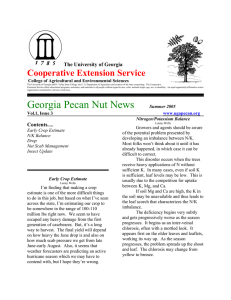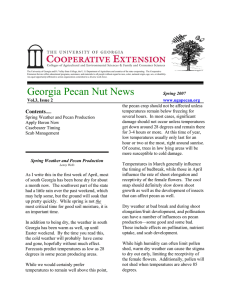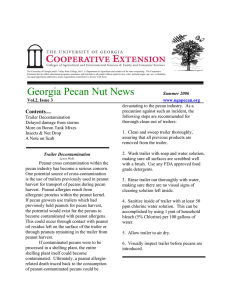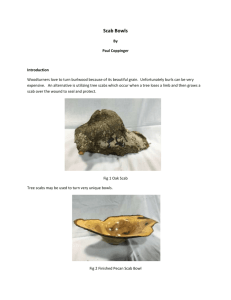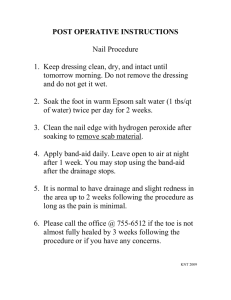Managing Pecan Scab Tim Brenneman Department of Plant Pathology University of Georgia, Tifton
advertisement
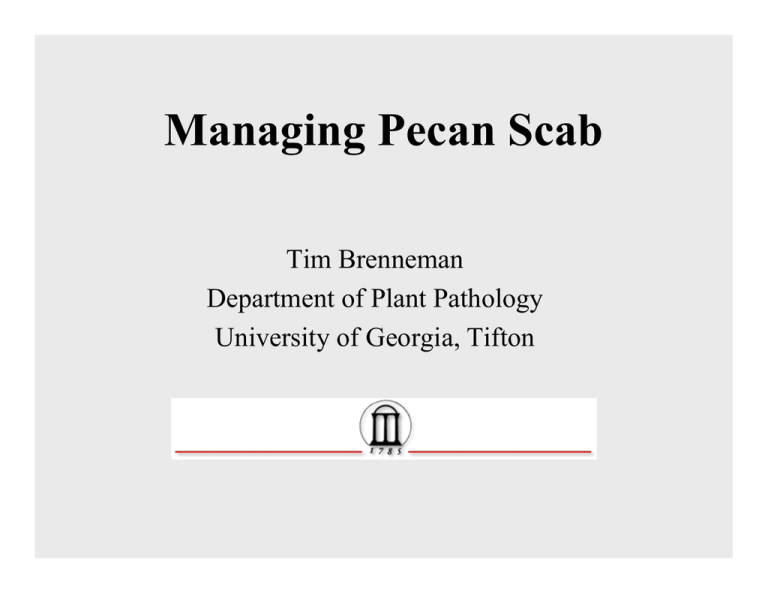
Managing Pecan Scab Tim Brenneman Department of Plant Pathology University of Georgia, Tifton A Recap of Pecan Scab in 2013! To Restate the Obvious Situation – frequent rains and cloudy weather much of the season, then a drier fall Result – extremely high disease pressure* due to frequent infection periods, difficulty of timely spraying, fungicide washoff, etc. resulted in reduced yields and quality (not just related to diseases). Even had a little scab on some highly resistant cultivars like Excel. By mid July some fungicides were sold out! *Mainly scab but also had downy spot, anthracnose, etc. Cumulative Rainfall (Ty Ty, GA (April – Aug) No Silver Bullets or Magic Voodoo Juice for Scab! 1. Fixed factors – site selection, cultivars, etc. 2. Cultural practices – pruning, thinning, clearing surrounding vegetation, mowing, etc. (much of which focuses on improved air movement and drying) 3. Chemical control – the backbone of disease management, especially for susceptible cultivars in humid areas. TPTH (Group 30) (Super Tin or Agri Tin) • Excellent nut scab control, good on leaf scab; mainly used post-pollination, or as a mix with another fungicide • Misses a number of secondary diseases and has no systemic activity • Low resistance risk; CRITICAL TOOL FOR RESISTANCE MANAGEMENT DMI’s (Group 3) (Enable, Tebuconazole, Orbit, Quash) • Provide good control of leaf scab and secondary diseases (ex. zonate, anthracnose and powdery mildew); not as strong on nut scab, good prepollination choice • Some systemic movement and “kick back” • Medium risk (high??) of resistance, but appears to be developing fast in scab and anthracnose. Must be very careful to not overuse this chemistry. QoI’s or Strobilurun’s (Group 11) (Headline, Sovran, Abound) • Effective leaf and nut scab control, have been used more pre-pollination with mixes of DMI’s such as tebuconazole • Broader spectrum of disease control and some systemic movement • High Risk of Resistance- do not use more than 2 sequential or 3 total app’s per year Dodine (Group U12) (Elast) • Excellent leaf and nut scab control, has been used primarily for nut scab • Misses some minor diseases (anthracnose) and can cause leaf injury to some older cultivars (Moore, Van Deman, etc.) • Moderate Resistance Risk - Alternate with other fungicides or use as a tank mix (not much resistance detected now) Benzimidazoles (Group 1) (Topsin and formerly Benlate) • Very good leaf and nut scab control • Systemic and good on minor diseases • Revolutionized scab control in early 70’s until lost to resistance. Current data shows most populations now sensitive again – we could use this chemistry more. • High Resistance Risk - Must use with other fungicides and no more than 2 sprays per year Phosphonates/Phosphites (Group 33) (Phostrol, Prophyt, etc.) • Active on leaf and nut scab, but stronger on leaves. Truly systemic in xylem and phloem • Broad spectrum with activity on minor diseases, especially anthracnose • Can bioacumulate and cause injury if applied in low volumes and sequential app’s. Reported to delay shuck split with late app’s • Low Resistance Risk and different mode of action than other chemistries Combination Products (Absolute, Quilt, Quadris Top, Viathon, etc.) • • • • The wave of the future Provide leaf and nut scab control Broader spectrum of diseases controlled Built in resistance management, but lower rates an issue as resistance develops Are we pushing our spray programs to the limits, not just in terms of economics and disease control, but also label compliance and product stewardship? In 2013, YES! We are abusing tebuconazole! • It is added to many sprays “Just in case – it really doesn’t cost much of anything and it might help” • Labeled rates and numbers of applications are not always followed • Resistance is quickly developing in scab and other pathogens. It will affect the activity of Enable, Orbit, Absolute, Stratego, Quadris Top, Quilt, etc. • Abound (azoxystrobin) is about to go off patent and the same thing may happen. (Sovran, Absolute, Stratego, Quilt, Quadris Top, etc.) Tebuconazole (Folicur) (Excellent on leaf spot in 1994, resistance developed by 2005, but still effective on white mold) Bravo Full Season Bravo-Folicur Block Maximum number of sprays per season on pecans Tebuconazole TPTH Elast 32 oz 72 oz 18 pts 4 X 8 oz* 6 X 12 oz 6 X 3 pts * Cannot legally use additional tebuconazole in other products (ie. Absolute). Can legally use other DMI’s but adds huge resistance risk. 2014 UGA Program for Pecan Scab Fungicide Sensitivity Testing (Stevenson, Brenneman and Brock) • VERY IMPORTANT ISSUE!!! • More details later today from Dr. Stevenson • After 2014 we should know a lot more about fungicide resistance issues in the state How many sprays of XYZ should I use in a year? How many times are you spraying? Implications from Bananna FRAC Guidelines DMI’s – maximum of 8, < 50% of total QoI’s and Benzimidazoles -- no consecutive QoI app’s -- maximum of 3, <33% of total How important are prepollination sprays? In some drier years they provide little, if any, benefit for scab control or yield. BUT, in wetter years they are critical to prevent early leaf infections and inoculum production! Also important for other diseases like downy spot Effects of Pre-pollination Spray Dates, 2013 Light green Effect of early spray timing, 2013 (Super Tin / Elast - all trt’s sprayed app’s 4-10) Leaf Scab November Leaf Retention 10 75 % Defoliation % Disease * 8 6 4 50 25 2 0 0 Sprays Sprays Untrt 1&3 2 Untrt 1&3 2 How important are prepollination sprays? In 2013 they were needed. If it rains at all in the spring of 2014 they will be absolutely essential! Another Result of 2013 – Lots of Scab Inoculum! (spores from shucks 1 ½ years later) Stromata on wood is biggest problem. What should we do? -- some folks cut it out of their young trees -- Be prepared to start spraying early, especially if it is rainy. -- Pray for dry weather! (Without water it will not matter) What about dormant sprays? • Currently evaluating lime-sulfur dormant sprays . Evidence for activity on Phomopsis and other pathogens in other crops • Caustic and “burns out” the overwintering inoculum (also caustic to equipment – covering sprayers with diesel and/or immediate clean up is suggested!) • NOT A RECOMMENDED PRACTICE ON PECANS AT THIS TIME. (Expensive and no data to justify a recommendation) Early Sprays? • Known benefit from spraying actual leaves; wait until green up to get benefit on foliage and overwintering lesions • Elast MAY have effects on sporulation (normally I recommend it later season for nut scab, but could use the 50 oz rate for first spray, then go to a Sovran, Absolute, Tebuconazole, etc. for other early sprays) Effect of early season spray timing (Super Tin / Elast - all trt’s sprayed app’s 4-10) Nut Scab Incidence 100 % Disease * 75 50 25 0 Sprays Untrt 1&3 2 How much drying time do I need for my fungicides? • Compared Folicur, Bravo/Moncut, and Abound programs • 0, 6, 12, 24, 48 and 96 hours from spray to irrigation (0.5 in.) • 7 reps, 3 years • 154 total microplots Woodward, Brenneman & Mullinix, 2012 Plant Disease Effect of Irrigation after Fungicide Application on Leaf Spot* (Nonirrigated = 0.6) 3 Lesions per leaf 2.5 2 1.5 1 0.5 0 0 24 48 72 96 Hrs from Trt to Irrigation * Mean data for Bravo/Moncut, Folicur & Abound programs, 3 years Effect of Irrigation Timing on Pod Rot from White Mold* (Nonirrigated = 49%, Bravo = 67%) 60 % Pod Rot 50 40 30 20 10 0 0 24 48 72 96 Hrs from Trt to Irrigation * Mean data for Bravo/Moncut, Folicur & Abound programs, 3 years Formulation affects uptake of Azoxystrobin (AZ) Uptake of AZ from Quilt is higher than from Abound alone Uptake of AZ into the leaf cells is higher than PYR or TFX Quilt AZ Headline PYR Stratego TFX Abound AZ % Radiochemical Recovered 80 60 40 20 0 0 1 2 3 4 5 6 Time (Days After Treatment) 7 Dave Bartlett : JH : Biokinetics Group : May 2004 Formulation affects uptake of Propiconazole Uptake of PPZ from Quilt is higher than from Stratego or Orbit Quilt PPZ Orbit PPZ Stratego PPZ 80 Uptake (% of applied) 60 40 20 0 0 1 2 3 4 5 6 7 Time (Days After Treatment) Dave Bartlett : JH : Biokinetics Group : May 2004 How much drying time do I need for my fungicides? More is clearly better – to get maximum benefit from each spray requires more time than just “until the leaf dries” Varies with fungicide – systemics less vulnerable than protectants, but systemics vary widely in time of uptake Will we ever have a real systemic fungicide for pecans? Yes, we already have several! (But not the degree of systemicity he wanted!) - Compensate for poor spray coverage - Makes product less prone to wash off - Improve protection of rapidly expanding plant tissues (ex. pecan shoots in spring) Systemic Movement – with few exceptions means LOCAL OR UPWARD ONLY Sample after 4 and 7 days Image for movement to : growth present at time of application new growth emerged after application Treat Sample (exclude treated stem) Dave Bartlett : Biokinetics : Jealott’s Hill : Soybean Symposium : Oct 2004 Systemicity of Azoxystrobin (AZ) 8 7 AZ is the most systemic strobilurin More AZ moves following Quilt application than Abound Quilt AZ 6 5 4 Abound AZ 3 2 Stratego TFX 1 0 Headline PYR 3h 6h 1d 3d 7d 3h 6h 1d 3d 7d 3h 6h 1d 3d 7d 3h 6h 1d 3d 7d Time after application Dave Bartlett : JH : Biokinetics Group : May 2004 Systemicity of Propiconazole More PPZ from Quilt moves systemically than from Orbit or Stratego This is because of the higher uptake from Quilt - formulation does not influence translocation per se 20 18 Quilt PPZ 16 14 Orbit PPZ 12 Stratego PPZ 10 8 6 4 2 0 3h 6h 1d 3d 7d 3h 6h 1d 3d 7d Time after application 3h 6h 1d 3d 7d Dave Bartlett : JH : Biokinetics Group : May 2004 This data is from other crops – what do these products do on pecan leaves and nut shucks? Stay tuned – we’re trying to find out! Will spray adjuvants improve my disease control? Theoretically yes! Remarkably little data, but they can affect uptake by plant (ex. Previous slides of formulation effects) Some growers feel they are beneficial Varies with fungicide – systemics most likely to benefit. Elast is a cationic surfactant. Effect of adjuvants on efficacy of Super Tin 80WP 100 90 80 % Disease * 70 60 50 40 30 20 10 0 Dougherty Tin Bertrand and Brenneman, 1995 Tin + Latron B-1956 Mitchell Tin + Bond Do aerial applications really do any good? YES, at least in the upper part of the tree. They can supplement but not replace a good ground spray program. Good place for systemics! Effect of aerial applications for pecan scab (Schley, 3 yrs data) High (> 40 ft) 40 40 30 30 % Disease % Disease * Low (<15 ft) 20 20 10 10 0 0 Application Application Air + Grd Ground Air Check Bertrand and Brenneman Air + Grd Ground Air Check Effect of aerial applications for pecan scab (Desirable, 3 yrs data) High (> 40 ft) 40 40 30 30 % Disease % Disease * Low (<15 ft) 20 20 10 10 0 0 Application Application Air + Grd Ground Air Check * Bertrand and Brenneman Air + Grd Ground Air Check Effect of aerial applications of Enable/AgriTin for pecan scab (Bertrand, 2001) High (> 40 ft) 100 100 75 75 % Disease % Disease * Low (<15 ft) 50 50 25 25 0 0 Application Application Air + Grd Ground Air Check Air + Grd Ground Air Check * Air app’s w/ & w/out NIS – no difference low, but more disease high w/ the NIS! Is it better to tank mix partial rates of fungicide or alternate sprays with full rates? % Disease Nut Scab Control with Tank Mixes of Half Rates vs Alternating Full Rates of Super Tin and Elast (12 oz and 50 oz) 100 90 80 70 60 50 40 30 20 10 0 2103 2012 2011 Tank mix 2010 Alternation 2008 2006 % Disease Nut Scab Control with Tank Mixes of Half Rates vs Alternating Full Rates of Enable and Elast (8 oz and 50 oz) 100 90 80 70 60 50 40 30 20 10 0 2103 2012 2011 Tank mix 2010 Alternation 2008 2006 Tank Mixes vs Alternations? • Tank mixes of Elast and Tin tend to do better than alternations of similar rates (additive or synergistic?) • Alternating full rates of Elast and Enable tend to do better than tank mixes (probably due to gradual reduction in sensitivity to Enable) How did the different products perform this year? Effect of Fungicides on Leaf Scab Severity (Desirable, Tifton, 2013; LSD = 3.1) (“Alt” programs are w/ Tin 6 oz + Elast 25 oz) 25 Sovran, 3.2 oz % Disease 20 15 Kphyte, 2 qt Rampart, 2 qt Headline 7 oz 10 5 Abound 12 oz Tin/Elast (6/25 oz) Orius, 8 oz 0 Nontreated Effect of Fungicides on Nut Scab Severity Desirable (South Block), Tifton, 2013 (LSD = 7.0) (“Alt” programs are w/ Tin 6 oz + Elast 25 oz) 100 90 % Disease 80 70 60 50 Sovran, 3.2 oz Kphyte, 2 qt Rampart, 2 qt Headline 7 oz 40 Abound 12 oz 30 20 Tin/Elast (6/25 oz) 10 Orius, 8 oz 0 Nontreated Effect of Fungicides on Nut Scab Severity % Disease Desirable (North Block), Tifton, 2013 (LSD = 5.9) (“Alt” programs are w/ Tin 6 oz + Elast 25 oz) 100 90 80 70 60 50 40 30 20 10 0 Quadris Top, 10 oz FungiPhite, 32 oz FungiPhite + Abd 9 oz Tin/Elast Check Generalizations on Fungicides • Tin and Elast still core products for nut scab • Triazoles still important but resistance is developing quickly (becoming risky to use a “solo” triazole) • Topsin could be used more than it is • Strobilurins (like Abound) will be used more, but will probably also have resistance issues • Phosphites- have good potential for expanded use • SDHI’s – used on other crops, but haven’t been outstanding for pecan scab. What are Phosphites? Derived from Phosphorous acid, NOT Phosphoric acid which is a fertilizer Truly systemic and very stable in plants May stimulate host defenses, and good direct activity on Oomycetes Activity reported on other pathogens K-Phite, Fungi-phite, Prophyt, etc. (not all phosphites are labeled for scab) Mixes coming (ex. Viathon, phosphite + Teb) Phosphite Summary (K-Phite, Fungi-phite, Prophyt, etc.) • Have efficacy on pecan scab and anthracnose; stronger on leaves than nuts • Potential for leaf injury with lower spray volumes • Have a good spectrum of activity with a different mode of action • No indication of delayed shuck split with 5 app’s • Granular phosphites were NOT effective in 2013 Ingram & Brenneman - Anthracnose Could scab be controlled on Desirable’s in the deep south in 2013? Surveyed 8 very well managed orchards in late August and rated nut scab low in the trees (clearly more disease up high in most cases) Nut Scab in Commercial Orchards, 2013 (All well maintained Desirable orchards, south GA) (Nut scab rated at ground level) 100 Farm 1A Farm1B Farm 2 Farm 3A Farm 4A Farm 3B Farm 5 Farm 4B % Incidence 80 60 40 20 0 Farms Nut Scab in Commercial Orchards, 2013 (All well maintained Desirable orchards, south GA) (Nut scab rated at ground level) 50 Farm 1A Farm1B Farm 2 Farm 3A Farm 4A Farm 3B Farm 5 Farm 4B % Severity 40 30 20 10 0 Farms What did it take to control scab on Desirable in South GA in 2013? 4/8 4/16 4/30 5/14 5/22 5/29 6/6 6/12 6/21 Absolute (5 oz) Tin (12 oz) + K-phite (1 qt) Tin (12 oz) + Elast (25 oz) Tin (12 oz) + Topsin (20 oz) Absolute (5 oz) + Teb (6.4 oz) + K-phite (1 qt) Tin (6 oz) + Elast (50 oz) Tin (6 oz) + Elast (50 oz) Quadris Top (14 oz) + Sulfur (2 qt) Tin (12 oz) + Elast (25 oz) What did it take to control scab on Desirable in South GA in 2013? 7/1 7/8 7/15 7/22 7/29 8/7 8/12 Quadris Top (14 oz) + Sulfur (2 qt) Tin (6 oz) + Elast (50 oz) Tin (12 oz) + Topsin (20 oz) + Sulfur (1 qt) Tin (12 oz) + Kphite (2 qt) Syllit (50 oz) + Tebuconazole (6.4 oz) Absolute (7.5 oz) + Tin (6 oz) + Sulfur (1 qt) Syllit (50 oz) + Tin (6 oz) 15 sprays (& counting) What did it take to control scab on Desirable in South GA in 2013? 1. Excellent spray coverage 2. Started early and stayed on a tight (7-10 day) schedule most of the season 3. Open orchards with good air flow 4. Premium fungicides & full rates, usually combo’s 5. Help from on high (some aerial application and some from higher than that!) Can we grow Desirables economically in the deep south? • Bill Goff – “I will no longer recommend ‘Desirable’ for planting in the southern half of the pecan growing areas in SE states” (Jan. 2014 Pecan South) • Excellent review of the pros and cons, and outlines alternatives • Moving target – need a crystal ball! Can we grow Desirables economically in the deep south? • Been a lot of money invested that says we can • $0.50/lb X 1000 lb/A = $500/A can buy a lot of fungicide! • Will the current price structure continue? • We better be good stewards of our fungicides • Scab WILL get worse on susceptible cv’s!! All farming is a gamble – growing scabsusceptible cultivars in the humid SE is a high stakes game! 2013 was a wild ride - What doesn’t kill you makes you stronger! To add • • • • • Current resistance info Systemic movement, peanut Kyle growth shoot data Change sprayers (add volute, etc.) AU-PECAN
